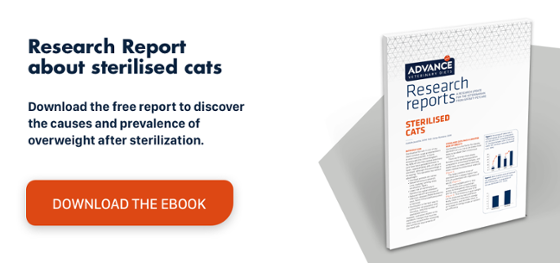Sterilisation of female cats: tips for a successful postoperative period
Sterilisation: advantages
Sterilisation is a routine surgical procedure in veterinary practice intended to prevent reproduction in females by removing the female gonads (oophorectomy) or by completely removing the ovaries and uterus (ovariohysterectomy).
↓ Download this free guide to find out more about caring
for sterilised cats and their nutritional requirements ↓
The main aim of this intervention is to eliminate the reproductive capacity of female cats. However, sterilisation also offers other advantages:
- Reduces the risk of developing hormone-dependent diseases in the future, such as mammary tumours.
- Prevents the onset of pyometra and phantom pregnancies.
- Prevents the onset of behavioural changes associated with sexual maturity: oestrus-related rubbing, vocalization and attitudes.
Despite the popularity of this technique, we must still underline the importance of postoperative patient management and care as there are certain complications, such as a surgical site infection or wound dehiscence, that can and should easily be avoided.
Would you like to learn more about the points to consider when deciding whether to sterilise a pet?
Postoperative care
Below is a description of the different practices to ensure sterilised cats make a good recovery.
Wound healing and protection
One of the main aspects in the postoperative management of female cats is surgical wound care. It must be kept clean and free of scabs, treating it three times a day with disinfectants such as povidone-iodine or chlorhexidine, applying gentle pressure with a gauze pad.
Another vital consideration at this stage of the process is the use of an Elizabethan collar or bodysuit to protect the surgical wound, as the patient will attempt to lick it or remove the stitches.
Medication
Pharmacotherapy comprises establishing an antibiotic and anti-inflammatory regimen to prevent surgical wound site infection and a concerted effort, insofar as possible, to alleviate any discomfort or pain patients may manifest.
Antibiotics should be prescribed for at least 1 week.
Diet
As sterilisation triggers a serious of metabolic changes in female cats, vets and owners must consider changing the patient’s diet after recovering from surgery.
Advance’s diets for male and female sterilised cats are tailored to the different stages of their life:Junior Sterilized, Adult Sterilized and Senior Sterilized. We also have diets for any other individual needs they may have:Hairball Sterilized, Sensitive Sterilized and Urinary Sterilized Low Calorie.
The key to these diets is their modified composition that restricts energy and boosts L-carnitine intake; this amino acid accelerates fat metabolism, thus helping to control the patient’s weight and body condition by preventing unnoticed weight gain.
Following sterilisation, never simply reduce the cat’s daily ration as this would imply a decreased intake of essential nutrients; rather they should be given a diet modified especially for sterilised animals.
Management
Finally, the patient’s activity should be temporarily reduced in the postoperative period, that is, it should not make any sudden movements that could risk damaging the sutures or surgical wound.
However, once the wound has healed, sterilised cats must increase their physical activity to prevent weight gain.
Conclusions
The sterilisation of cats is a very common procedure in veterinary clinics that is mainly carried out to prevent unwanted reproduction. The postoperative period is important to avoid complications during the cat’s recuperation, so wound healing and protection, pharmacotherapy, dietary changes and patient management are essential for a speedy recovery.

